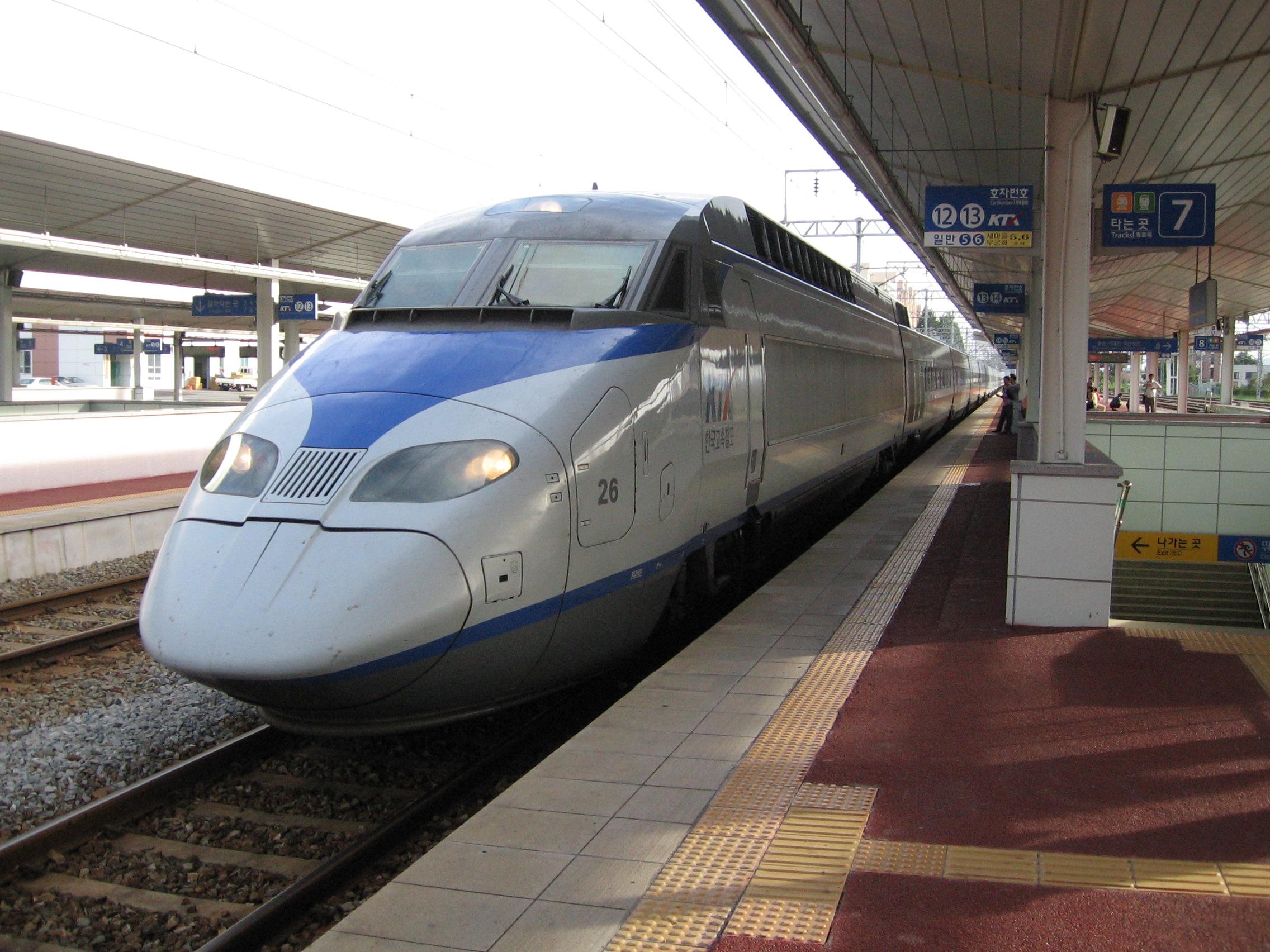- Korea Train Express
Infobox Korean name
logo=KTX_logo.gif
logowidth=67px
caption=KTX train
hangul=한국고속철도
hanja=韓國高速鐵道
mr=Han-guk Kosok Ch'ŏldo
rr=Han-guk Gosok CheoldoThe Korea Train eXpress (KTX) isSouth Korea 'shigh-speed rail system. It is operated byKorail . The train's technology is largely based on the FrenchTGV system, and has a top speed of 350 km/h, limited to 300 km/h during regular service for safety. [cite web|url=http://info.korail.com/2007/eng/ein/ein01000/w_ein01100.jsp|title=Railroad Information|accessdate=2008-01-08|publisher=Korail Korean Railroad] OnDecember 16 ,2004 , the Korean-madeHSR-350x achieved an experimental top speed of 352.4 kilometers per hour. [cite web| url=http://eng.kitech.re.kr/c6_info/index.php?mode=view&sub1=1&sub2=1&idx=14 |title=HSR350x Tops 350km/h |date=2005-05-31 |accessdate=2006-12-15 |publisher=KITECH ]History
After 12 years of construction, the Gyeongbu Line (connecting
Seoul toBusan viaDaejeon andDaegu ) and the Honam Line (Yongsan toGwangju andMokpo ) opened onMarch 31 ,2004 . Presently using high-speed track for only part of the distance (from Seoul to Daegu), the new line cuts travel time between Seoul and Busan from the Saemaul-ho's 4 hours and 10 minutes to 2 hours and 40 minutes, and between Yongsan and Mokpo from 4 hours and 42 minutes to 2 hours and 58 minutes.cite web|title=KTX Overview |url=http://ktx.korail.go.kr/overview2/index.html |language=Korean |accessdate=2007-01-18 |publisher=KTX website] A further improvement to 1 hour and 56 minutes on the Gyeongbu Line is expected in2010 , when the train will begin to run entirely on high-speed tracks.The initial trainsets are TGV-A models with minor modifications. In all, 46 trains were built - the initial twelve in
France byAlstom , the remainder in South Korea byROTEM . [cite web |title=A TGV for Korea; The parties involved |url=http://www.webmag.transport.alstom.com/eMag/externe/international/korea/ktx/mar2004/1/221.asp |date=2004-03-29 |accessdate=2007-03-08 |publisher=Alstom] The tracks were built with technical assistance fromSNCF technicians.The next generation of KTX trains, the
HSR-350x (KTX II), is based on the TGV-R trainset, but with over 80% locally produced in Korea. The trains may be introduced into service as early as 2009.cite web |url=http://www.railjournal.com/altfeature1.shtml |title=Korea’s railways face a bright future |date=2008-07-01 |accessdate=2008-07-01 |publisher=Simmons-Boardman Publishing Corporation|archiveurl=http://findarticles.com/p/articles/mi_m0BQQ/is_7_48/ai_n27948208?tag=untagged|archivedate=2008-07-02]Future
KTX network map Shared track (KTX) Gyeongbu Line (KTX) Gyeongbu Line (normal) Honam Line (normal) Construction of the second phase linking
Daegu toBusan started in June 2002, and is expected to be completed by the end of 2010. The new section follows a different, more easterly route, with new stations planned forGyeongju andUlsan .High-speed track for the
Honam Line from Seoul viaOsong toGwangju andMokpo is also planned, with construction to start in 2009 for tentative completion in 2014.KTX services running partly on ordinary track are planned for the
Jeolla Line toSuncheon andExpo 2012 siteYeosu , branching from the main Honam Line atIksan ." [http://www.encyclopedia.com/doc/1G1-161200018.html KTX takes the lead in Korea] ", David Briginshaw, "International Railway Journal" 1.1.2007] Operations may start as soon as 2009, although the Iksan-Yeosu line has a top speed of only 120 km/h, currently being increased to 180 km/h. TheSamnangjin -Jinju line is also being doubled and electrified to allow KTX operations by 2014.A spur line from Seoul to
Gangneung on the northeast coast was under consideration, but seems to have been shelved after Korea's bid for the2014 Winter Olympics failedFact|date=November 2007.Ridership
When introduced in April 2004, KTX ridership was an average of 70,900 passengers per day. This number was more than on the busiest French
TGV line, but that on a more expensive line, and well short of initial expectations of 200,000. While earning an operational profit of about 2.1 billion won per day, this amount was insufficient to service the loans, as the construction cost grew from an initial estimate of 5 trillion to an actual 18 trillion Korean won (approx. 5 billion to 18 billion US dollars). On January 14, 2005, Prime MinisterLee Hai Chan stated that KTX was a political failure.However, less than two years after the introduction of KTX service, the market share of rail on the Seoul-Busan sector increased from 38% (2003) to nearly 61% (2005), with air travel dropping from 42% to 25% and road travel falling from 20% to 14%. On
January 9 ,2006 ,Korail reported that average daily ridership in December 2005 had reached 104,600, an increase of almost 50%, with daily operating profit up to 2.8 billion won and financial breakeven expected by early 2007. [cite web |url=http://times.hankooki.com/lpage/nation/200601/kt2006010917353911990.htm |title=KTX Tops 100,000 Passengers Per Day |date=2006-01-09 |accessdate=2006-12-15 |publisher=The Korea Times ] In 2006, KTX carried 36.49 million passengers (against 32.37 million in 2005). On theLunar New Year in 2007 (February 18 ,2007 ), KTX carried a record 158,967 passengers. The 100-millionth rider was carried after 1116 days of operation onApril 22 ,2007 , generating an income of 2.78 trillion won. [cite web |url=http://ktx.korail.go.kr/ROOT/ktx/notices2/notices_view.jsp?num=127&page=2&field=wtitle&field_value= |title=KTX이용객 1억명 돌파(2) |date=2007-04-22 |accessdate=2007-07-13 |publisher=Prime Business Journal |language=Korean] Throughout May 2008, the average ridership reached 160,000 passengers per day.Technical issues
According to an investigation by the
Grand National Party in 2006, the KTX broke down 160 times in the span of three years, [cite web |url=http://www.pbj.co.kr/news/read.php?idxno=17777 |title=KTX 고장나면 다른 차량 부품 떼어 "땜질" |date=2006-10-13 |accessdate=2006-12-15 |publisher=Prime Business Journal |language=Korean] an average of once per week. Obtaining spare parts for the KTX from French suppliers can be a time-consuming process, which has resulted in parts being cannibalized from functional trains.ee also
* Main terminal at Seoul Station
*List of Korea-related topics
*Transportation in South Korea References
External links
* [http://ktx.korail.go.kr/eng/index.html Korea Train eXpress]
* [http://ktx.korail.go.kr/eng/flash/map.swf Route Map]
* [http://www.jrtr.net/jrtr40/pdf/f08_kim.pdf JRTR Issue 40: Transportation Revolution, the Korean High-Speed Railway]
Wikimedia Foundation. 2010.
